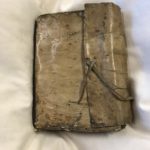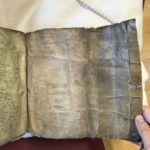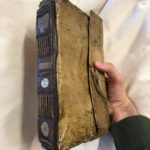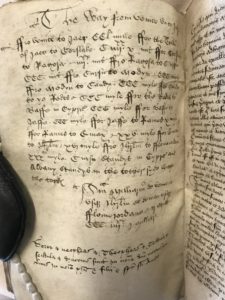
Blog-post author, Dr Laura Morreale
Fordham University
– Lmorreale3@fordham.edu
It was the year 1250 and John of Joinville — who in his golden years would write the monumental Life of St. Louis—was sick. In 1248, a young John had joined Louis IX of France in Cyprus during the first of the King’s ill-fated crusades to the Holy Land, a trip that John later characterized in his writings as a pilgrimage, and in which he regularly identified himself as a pilgrim.[1]

By 1250, however, it was clear that the campaign was not going well. The French troops, who had successfully invaded Egypt in June of 1249, were compelled to retreat from their advanced positions on one of the Nile tributaries early in April of 1250, and Louis, John, and their noble companions were captured by enemy forces on the fifth of that same month. The royal entourage was held prisoner in Egypt for several weeks, then finally ransomed on May 6, 1250. Once released, they journeyed to the port city of Acre and arrived, exhausted, a week later. At this point the French King and his troops reassessed whether to remain in Palestine and resume their efforts, or abandon their cause in the Holy Land and return to France without delay. John counselled Louis to stay, and it was this advice that the King ultimately heeded. Following this decision, Louis, John, and a sizable French contingent remained in residence in Acre until 1254.
From his own reports, however, John was not just ill upon his arrival in Acre in 1250; he feared he was near death. He was so weak he could no longer dine with the King, who had repeatedly requested his presence during mealtimes. John was instead compelled to convalesce at the nearby parish church of St. Michael, where he lodged at the church priests’ house, located between the Hospitaller palace and the northern wall of Acre’s old city.[2]

Perhaps in response to his frail condition, or because he could hear a steady stream of final blessings pronounced over the Christian dead coming from the chamber adjacent to his own sickroom, Joinville created a devotional work based on the tenets of the Apostles Creed, now generally known as his Credo.[3] This highly interactive book, created between August of 1250 and April of 1251, was replete with images, scriptural passages, and personal recollections designed to draw Joinville’s reader-listener into a full articulation of each article of the Christian faith. [4]
The work Joinville created was no simple undertaking. The Credo featured a point-by-point presentation of words and images crafted to work together to reinforce each successive tenet of the Creed. The integrated program served as a kind of backstop of faith that Christians would consume both aurally and visually at their hour of death.[5] Joinville himself notes that he designed the Credo to be read aloud to the Christian faithful, “so that in the final moments, when temptation to sin was at its greatest, Christian believers might fill their eyes and ears with the tenets of the faith and thereby be saved.”[6]

Through the Credo’s words and images, reader-listeners were drawn into a physical, sensory, and spiritual engagement with each article of his faith. The author indicated repeatedly that the book’s consumers would see (verrés) each of the elements of the faith depicted in accompanying images, and hear the scriptures that elucidated the meaning of each point read aloud. He mentions, among many others, “The prophesy of deeds on the cross, that is Isaac, that you will see hereafter illustrated,”[7] or “The prophesy of the works of he who was placed in the tomb, that is concerning Jonas, that you see illustrated here.”[8]
Although he does not explain why the hour of death was the moment when a Christian’s faith might be severely tested, Joinville did place the Credo within the arc of his own personal experience, narrating events that had occurred during his imprisonment in Egypt just a few months before. Joinville recounts that
In reference to His [Christ’s] resurrection I will tell you what I heard of in prison the Sunday after we had been captured … We heard a great number of people cry out. We asked what it was, and they told us that it was our people whom they had placed in a large field, encircled with an earthen wall: those who did not want to renounce [their faith], they killed, those who did renounce, they left alone. [9]
After this alarming scene, Joinville explains that he and his fellow prisoners also feared for their lives shortly thereafter, when negotiations with their captors had come to an impasse and several young Saracens crowded into their quarters, heavily armed. Thankfully, he reports, they were delivered from harm by an elderly man who entered the tent shortly thereafter, assuring Joinville and his fellow prisoners that they would be saved if they remained steadfast in their faith. It is in this passage particularly that we see how Joinville’s Credo can, in some ways, be understood as a pilgrim’s book, and his trip to the East, a journey of faith.
While it is remarkable to hear of Joinville’s own struggles, to see his attention to the needs of his fellow Christians pilgrims and his acknowledgement that death was a real possibility during such a journey, it is also striking to consider the material realities that would have been required to create a work like the Credo in thirteenth-century Acre. Although we no longer have Joinville’s autograph from the 1250s, three manuscripts of the Credo remain, one which was created in Acre in the 1280s, thereby attesting to the continued presence and impact of the work in the East. But even without the author’s own copy, the Credo’s text, required images, and stated format reveal how Joinville imagined his book would be fabricated and consumed in the context of the Latin Christian community of Acre.
Joinville assumed he would have access to the materials, skilled scribes, painters, and illuminators to transform his words and the images that accompanied them from the vision in his own mind into an actual, physical book. He also anticipated an audience of fellow believers who would receive and use his book according to his design. This was clearly not an outlandish presumption, as Louis IX also commissioned at least one costly book during his time in Acre, a translation of the New Testament into Old French, now known as the Acre Bible.

The fabrication of both the Credo and the Acre Bible would have required skilled interpreters or writers of French as well as artists, illuminators and sources for parchment and the other material needs of book production. All of these resources were clearly available at this time in Acre, and formed part of the local pilgrim economy, even if the pilgrims who commissioned these works were of exceptionally high status.
The story of the Credo does not end in Acre in 1251, however. John eventually regained his health, and remained in the East with the King until his departure in 1254. Back in France in 1287, Joinville returned once again to his Credo, this time appending to his original text a prologue that explained how and why the work was first produced. [10] Thus the Credo is precious evidence not only of the creation of pilgrim’s book in Acre, but also of the memories of that same pilgrim, returned safely to France, who looked back on his writing and on the book he had commissioned in the East some thirty years earlier.
Acknowledgement
Thanks to Jamie Doherty and Caroline Paul for their help with the Credo.
References
- [1] Caroline Smith, Crusading in the Age of Joinville (2006), 114-15.
- [2] Denys Pringle, Churches of the Crusader Kingdom, Volume 4, (2009), 57.
- [3] Text and Iconography for Joinville’s Credo, ed. Lionel Friedman (1958).
- [4] Aden Kumler, Translating Truth (2011), 68.
- [5] Michael Curschmann, “The performance of Joinville’s Credo,” in Medieval and Early Modern Performance in the Eastern Mediterranean, ed. Arzu Öztürkmen and Evelyn Birge Vitz, (Turnhout: Brepols, 2014) 63-76 at 63.
- [6] Credo, ed. Friedman, 51; Image from Credo du sire de Joinville, ed. and trans. Artaud de Montor (1837), http://gallica.bnf.fr/ark:/12148/bpt6k3156549/f22.image
- [7] “La profecie de l’evre suer la crois, ce est de Ysaac, qu vous verrés ce après point,” ibid., 35.
- [8] “La profesie de l’euvre de ce qu’il fu mis ou sepulcher si est de Jonas, que vous veez ci point,” ibid., 37.
- [9] Ibid., 39-40.
- [10] Joinville’s prologue explains, “Et je, pour esmovoir les gens a croire ce de quoi il ne se pooient soffrir, fit je premier faire cest euvre en Acre,” Credo, ed. Freidman, 30.









